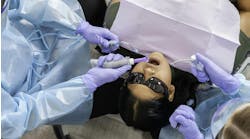By John Cahill, MBA
Rules of thumb normally don’t reflect the real value of something that is changing hands. Using a rule of thumb, for example “65% of gross collections” or “two times net income,” appears to be an easy way to value a dental practice. However, as any owner knows, no two practices are identical and should never be appraised so simplistically.
The value of a practice is comprised of two primary elements — tangible assets (dental equipment, furnishings, fixtures, and supplies), and intangible assets (location, phone numbers, parking, accessibility, quality of patients, quality of staff, office systems, competition, appearance of the facility, and practice revenues and discretionary net income, to name a few).
A common rule of thumb is to value a practice at an amount equal to 55% to 75% of average collection. The problem with this formula arises when two very different practices that are producing similar annual collections are compared, as illustrated below:
The rule of thumb formula described here would not take any of these factors or differences into consideration, but would look only at the average annual collections and ignore the other factors. Each additional factor adds to or detracts from the value of the practice and needs to be considered. A formula based solely on annual collections would value “Practice B” greater than “Practice A” even though it is obvious that “Practice A” is a higher quality practice.
The valuation of professional practices is as much art as science. Thirty to 35 years ago, what little valuation that was done was derived primarily from rules of thumb published in various professional journals, and was generally performed by representatives from dental supply companies using the “SWAG” method (scientific wild a-- guess).
Over the years, dentistry has changed dramatically. Payment systems through third-party carriers, Independent Provider Organizations (IPOs), and Preferred Provider Organizations (PPOs) have affected dental practices in terms of fees, size of practices, the necessity for accepting assignment, completion and complexity of insurance, and endless other operational burdens. Competition has also increased over the years in most urban areas. Marketing techniques, both internal and external, are the order of the day. The cost of opening a basic office with equipment and leasehold improvements has escalated significantly into the $250,000 to $400,000 range, making the purchase of an existing ongoing practice with positive income more economically sensible.
Just as the ability of new practitioners to easily open their own offices has disappeared in most areas, simplistic rules of thumb in valuation technology are no longer considered valid.
Because of the inherent complexities of a professional practice, an owner/doctor runs the risk of giving his or her practice the wrong value by using simple formulas. Few would disagree with the fact that it takes much more than “gross revenues” to make a quality practice. Therefore, valuing a practice using “gross revenues” as the only criteria of that value seldom makes good business sense.
Likewise, “two times net income” appears on the surface to be straightforward and simple, but in reality poses several obstacles in the valuation process. The biggest difficulty is in making the proper adjustment to the net income for “discretionary expenses” that many owners/doctors expense through their businesses but which would not be expenses for a new buyer, as well as not recognizing the age and condition of assets included in the sale.
This example illustrates how a mere “rule of thumb” could generate an inaccurate value for a practice when knowledgeable and proper adjustments are not taken into consideration.
John M. Cahill, MBA, of Western Practice Sales/John M. Cahill Associates, has more than 40 years of experience in the dental industry, including all aspects of appraisal, sales, purchases, and buy-ins in connection with dental transitions. Cahill is an emeritus member of ADS Inc. He can be reached at (888) 416-5724, ext. 530, (800) 641-4179, or [email protected]. Visit his Web site at westernpracticesales.com.





